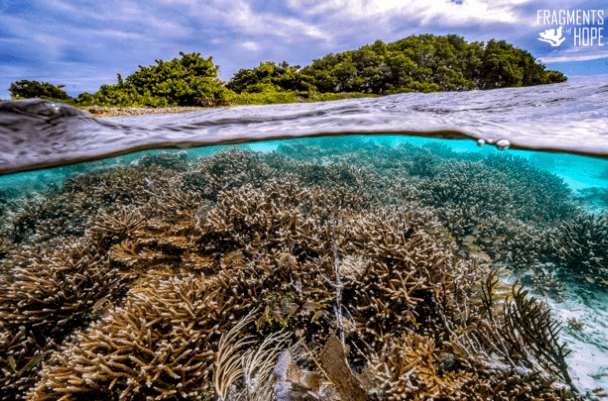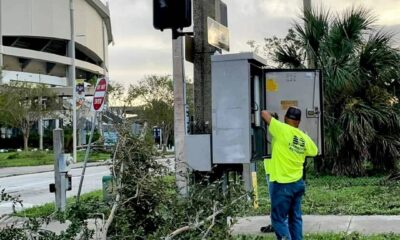Thrive
USF receives $20 million for coral, mangrove protection

The University of South Florida recently received a $20 million grant to help sustain and replenish coral reefs and mangroves that protect coastlines from dangerous wave energy and sea level rise.
Announced Sept. 7, the National Science Foundation grant will aid a USF-led interdisciplinary team of researchers as they develop a standardized approach to protecting those critical ecosystems. Civil and Environmental Engineering Professor Maya Trotz oversees the research team, which includes university experts in her field, anthropology and marine science. It also features partners from six other academic institutions.
The goal is to create scalable and equitable engineering approaches that are easily replicable. Specifically, combining natural solutions, such as coral reefs and mangrove forests, with infrastructure – like seawalls and floodwater pumps – to address coastal erosion and sea level rise. Increasing environmental resilience to those threats can prevent the loss of life and millions in property damage.
“I hate to use a word like ‘economic valuation’ on something because not everything can be counted monetarily,” said Trotz. “But to put in terms that there’s more financing. There are more opportunities for, say, insurers to look at protecting and doing more with these ecosystems.”
According to a university release, the federal grant stems from the U.S. Coral Reef Conservation Act, which promotes the study, management and protection of those ecosystems. Similar legislation in Florida applies to mangroves.
The researchers hope to quantify the social and ecologic factors needed to develop effective policy changes and increase public and private investment into restoration and replenishment efforts. Due to its susceptibility to storm surge and sea level rise, and as the area is home to both coral reef and mangrove habitats, the USF team is focusing on the Biscayne Bay region in Miami. They also are traveling to the Mesoamerican Barrier Reef Complex in Belize and the U.S. Virgin Islands.
“What we hope to do is, work with at least three different geographies and different communities within those geographies,” said Trotz. “To sort of come up with a common language and framework that we want to use to make decisions about these nature-based solutions.”

Active coral restoration at Laughing Brid Caye National Park in Belize. Photos provided.
Nearshore coral systems, explained Trotz, protect coastlines by reducing wave energy. Waves impact the coast with more intensity as reefs degrade, increasing the potential for storm surges and erosion.
While Tampa Bay is no longer home to naturally occurring coral, the region does possess an expansive mangrove ecosystem. Those forests also reduce wave energy and erosion, said Trotz, by capturing sediment before it is swept back out to sea.
She said that once researchers identify community practitioners interested in collaborating on intervention and preservation efforts, they will pinpoint the restored coral’s impact on reducing wave energy. The group will also ascertain which species of coral provides the most benefit, and the best locations for reefs, and establish a set of best practices for duplication.
“Something that we will figure out and learn from this project is that the time frame for some of these nature-based solutions are a little slower, potentially, than a community would want when they see their beaches and land eroding,” noted Trotz.
She added that man-made solutions – even at the detriment to coral and mangrove ecosystems – may be necessary. Those decisions, said Trotz, are a critical aspect of the research.
The project is part of the National Science Foundation’s Coastlines and People Hubs for Research and Broadening Participation program, which Trotz said began in 2018. The USF-led research team includes experts from Boston University, Stanford University, University of Miami, University of California Santa Cruz, University of Virgin Islands and East Carolina University.
The group also works closely with the World Wildlife Fund, an international organization that works to reduce human impacts on natural environments; Fragments of Hope Ltd., which pioneers scalable coral reef restoration in Belize; and Black in Marine Science, which hopes to broaden participation in the field.
“Two of our challenges are one – really involving communities in our work,” explained Trotz. “And then this idea of broadening participation. So, people who have been underrepresented in decision-making in the science of these fields, how do we change that?”

Researchers from the University of South Florida, University of the Virgin Islands and Fragments of Hope collect water samples in Belize. Photo provided.
The project, said Trotz, utilizes convergence research. That emphasizes taking the time to forge relationships and collaboratively build on established science. She said the first step in the program is to build mutual trust and respect between the researchers and the communities they study.
The ultimate goal, she relayed, is to create an equitable, global model that pushes nature-based solutions so that coastal areas have the tools, knowledge and funding needed to protect their communities. In addition to expensive waterfront neighborhoods, researchers are also studying how to mitigate vulnerabilities to low-income populations with the inability to recover quickly from natural disasters.
“How do you put that into a decision-making tool?” said Trotz. So that you value where to have an intervention, those things are considered also, and it’s not just let’s look at property value, which could be slightly biased.”







